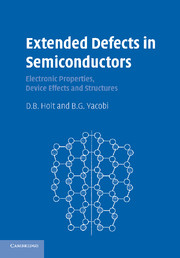Book contents
- Frontmatter
- Contents
- Preface
- 1 Semiconducting materials
- 2 An introduction to extended defects
- 3 Characterization of extended defects in semiconductors
- 4 Core structures and mechanical effects of extended defects specific to semiconductors
- 5 The electrical, optical and device effects of dislocations and grain boundaries
- 6 Point defect materials problems
- Index
- References
4 - Core structures and mechanical effects of extended defects specific to semiconductors
Published online by Cambridge University Press: 10 September 2009
- Frontmatter
- Contents
- Preface
- 1 Semiconducting materials
- 2 An introduction to extended defects
- 3 Characterization of extended defects in semiconductors
- 4 Core structures and mechanical effects of extended defects specific to semiconductors
- 5 The electrical, optical and device effects of dislocations and grain boundaries
- 6 Point defect materials problems
- Index
- References
Summary
Atomic core structure of dislocations
Extended defects disturb the crystal structure over many atomic distances in one or more dimensions. Those that continue to be of practical importance are interfaces and dislocations.
Extended defect cores in semiconductors are of relatively high energy due to the directional character of tetrahedral covalent bonds. If such a bond is bent from its tetrahedral direction by the displacement of the neighbouring atom, the bond energy rises rapidly. Hence sp3 bonds resist bending as if they were elastically stiff. If the neighbour atom is too far off the tetrahedral direction or at too great a distance, the bond energy would be too high and a broken or ‘dangling’ bond occurs. Hence, extended semiconductor defects can be modelled using plastic spheres with tetrahedrally drilled holes or protrusions and wire or plastic straws to connect them. Since such connections are also stiff and brittle, ball-and-wire (or caltrop-and-spoke) models can give insight, through their ease or difficulty of construction, into the likelihood of occurrence of particular atomic core arrangements in dislocations and grain boundaries. Such modelling was introduced by Hornstra (1958, 1959, 1960).
The high energetic cost of broken and strained bonds leads to a tendency for dislocations and grain boundaries to be crystallographically aligned to minimize the number of such bonds in the core. This contrasts with the curved or arbitrarily directed defects seen in many metals. Thus, dislocations in covalently bonded semiconductors are constrained to lie in deep crystallographic Peierls troughs (see Section 2.5.2 and Fig. 2.24).
- Type
- Chapter
- Information
- Extended Defects in SemiconductorsElectronic Properties, Device Effects and Structures, pp. 163 - 411Publisher: Cambridge University PressPrint publication year: 2007

